|
|
|
Sort Order |
|
|
|
Items / Page
|
|
|
|
|
|
|
| Srl | Item |
| 1 |
ID:
128416


|
|
|
|
|
| Publication |
2014.
|
| Summary/Abstract |
Air-conditioners and antibiotics are two technologies that have both been traditionally framed around individual health and comfort needs, despite aspects of their use contributing to social health problems. The imprudent use of antibiotics is threatening the capacity of the healthcare system internationally. Similarly, in Australia the increasing reliance on air-conditioning to maintain thermal comfort is contributing to rising peak demand and electricity prices, and is placing an inequitable health and financial burden on vulnerable heat-stressed households. This paper analyses policy responses to these problems through the lens of social practice theory. In the health sector, campaigns are attempting to emphasise the social health implications of antibiotic use. In considering this approach in relation to the problem of air-conditioned cooling and how to change the ways in which people keep cool during peak times, our analysis draws on interviews with 80 Australian households. We find that the problem of peak electricity demand may be reduced through attention to the social health implications of air-conditioned cooling on very hot days. We conclude that social practice theory offers a fruitful analytical route for identifying new avenues for research and informing policy responses to emerging health and environmental problems.
|
|
|
|
|
|
|
|
|
|
|
|
|
|
|
|
| 2 |
ID:
104887
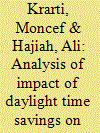

|
|
|
|
|
| Publication |
2011.
|
| Summary/Abstract |
In this paper, a detailed simulation-based analysis is conducted to assess the impact of adopting Daylight Saving Time (DST) on the electrical energy use and peak demand in Kuwait. The analysis focused on the impact of DST in the building sector since it represents 90% of electrical energy usage of Kuwait.
The simulation results indicate that the adoption of DST has mixed impacts for Kuwait. While the commercial and the governmental sectors may benefit from the DST, the private residences and apartment buildings can see both their annual energy use and peak demand increase slightly by adopting DST. The overall impact of the DST implementation is rather minimal with a slight increase energy use of about 0.07% and a slight reduction in peak demand of 0.14% or about 12 MW based on 2005 electrical peak demand for Kuwait.
|
|
|
|
|
|
|
|
|
|
|
|
|
|
|
|
| 3 |
ID:
109678


|
|
|
|
|
| Publication |
2011.
|
| Summary/Abstract |
We analyzed the peak load reductions due to a residential direct load control program for air-conditioners in southern Ontario in 2008. In this program, participant thermostats were increased by 2 °C for four hours on five event days. We used hourly, whole-house data for 195 participant households and 268 non-participant households, and four different methods of analysis ranging from simple spreadsheet-based comparisons of average loads on event days, to complex time-series regression. Average peak load reductions were 0.2-0.9 kWh/h per household, or 10-35%. However, there were large differences between event days and across event hours, and in results for the same event day/hour, with different analysis methods. There was also a wide range of load reductions between individual households, and only a minority of households contributed to any given event. Policy makers should be aware of how the choice of an analysis method may affect decisions regarding which demand-side management programs to support, and how they might be incentivized. We recommend greater use of time-series methods, although it might take time to become comfortable with their complexity. Further investigation of what type of households contribute most to aggregate load reductions would also help policy makers better target programs.
|
|
|
|
|
|
|
|
|
|
|
|
|
|
|
|
| 4 |
ID:
112302


|
|
|
|
|
| Publication |
2012.
|
| Summary/Abstract |
The prospect of a European Supergrid calls for research on aggregate electricity peak demand and Europe-wide Demand Side Management. No attempt has been made as yet to represent a time-related demand curve of residential electricity consumption at the European level. This article assesses how active occupancy levels of single-person households vary in single-person household in 15 European countries. It makes use of occupancy time-series data from the Harmonised European Time Use Survey database to build European occupancy curves; identify peak occupancy periods; construct time-related electricity demand curves for TV and video watching activities and assess occupancy variances of single-person households.
|
|
|
|
|
|
|
|
|
|
|
|
|
|
|
|
| 5 |
ID:
171372


|
|
|
|
|
| Summary/Abstract |
The European Union has recently decided to stop the policy of biannual clock changes in 2021. One reason is that the original rationale for the policy, energy savings, is not supported by a large portion of recent empirical studies. Whether the new permanent time will be standard time or the former daylight saving time has not been decided. Evidence on energy savings from daylight saving time is country-specific, and each country may choose its own time. We examine the effects of the policy in a country for which no studies on daylight saving exist, Slovakia. Using hourly data from the 2010–2017 period, we apply a difference-in-differences approach and estimate energy savings to equal 1% of annual electricity consumption. Alternatively, extrapolating the effect from the results of a previous meta-analysis on different countries, for Slovakia we obtain a smaller estimate, unlikely to exceed 0.5%. Moreover, our findings suggest that daylight saving time smooths the electricity demand curve.
|
|
|
|
|
|
|
|
|
|
|
|
|
|
|
|
| 6 |
ID:
176652
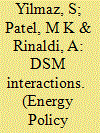

|
|
|
|
|
| Summary/Abstract |
To date, research has mostly focused on the impact of energy efficiency on the total electricity demand but not on the electricity demand profiles. To address this gap, we estimate the impact of energy efficiency measures and policies such as minimum energy performance standards on the peak load by developing a bottom-up model that generates Swiss household hourly electricity demand profiles per appliance based on time use data. The model estimates that evening appliance peak demand can be reduced by 38% when the appliances are replaced by the highest energy efficiency label available on market. We find that changing light bulbs to LED would have the same peak reduction as switching cooking or wet appliances to off-peak periods throughout the year. We also show that the evening appliance peak demand could reduce in 2035 by 24% thanks to the improvement of the energy performance of the stock. Cooking appliances, the least favourable appliances to be involved in demand response, is expected to be the highest contributors to the evening peak in 2035. Our findings show that policy makers should pay due attention to energy efficiency improvement not only for reducing electricity demand but also in order to reduce peak load.
|
|
|
|
|
|
|
|
|
|
|
|
|
|
|
|
| 7 |
ID:
162311
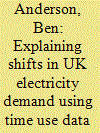

|
|
|
|
|
| Summary/Abstract |
Peaks in electricity demand generate significant negative environmental and economic impacts. As a result, recent policy and research attention has focused on the potential for temporal flexibility of demand, especially in the context of intermittent low-carbon generation. Much of this work emphasises the need to understand what makes up the peak and to engineer solutions to meet this ‘normal’ consumption. However, today's patterns of temporal consumption may only be a snapshot of continuing change. This paper uses UK household time-use survey data to analyse change in temporal patterns of activities over the last 40 years to shed light on apparent temporal shifts in overall UK electricity demand. The results highlight long term evolution in when and where people work, travel, eat, use media and carry out social activities. In particular they suggest that changing patterns of labour market participation may be contributing to shifts in food related, personal/home care and media activities which correlates with shifts in electricity demand. We conclude that both stable and dynamic social structures and forms of organisation have direct implications for policy debates around current and future flexible demand-side solutions.
|
|
|
|
|
|
|
|
|
|
|
|
|
|
|
|
| 8 |
ID:
176870


|
|
|
|
|
| Summary/Abstract |
The success of time-of-use (TOU) pricing, where consumers are charged higher rates during peak usage windows, depends on consumer flexibility—an assumption that may not be true for all households or activities. We draw on concepts from social practice theory to explore the flexibility of residential electricity consumption, examining both household rules that govern energy conservation and activities that comprise the peak demand period. Surveying 337 households in a Northern California city slated for TOU rates, our goal was to better understand household energy rules and peak activities; willingness-to-shift peak activities; and relationships between household rules, willingness-to-shift and electricity usage. While respondent demographics and estimated monthly electricity bill (our proxy for usage) were associated with following energy rules, motivations for following rules (e.g., environmental, monetary) dominated. For respondents’ willingness-to-shift peak activities, square footage, number of household members, and smart technology were important, along with energy rule participation and the number of peak activities. Energy rule participation was also associated with lower bills, while number of household members and peak activities were associated with higher bills. Our findings provide insights into pathways for modifying energy use during peak to allow for easier integration of renewables into the grid.
|
|
|
|
|
|
|
|
|
|
|
|
|
|
|
|
| 9 |
ID:
115662


|
|
|
|
|
| Publication |
2012.
|
| Summary/Abstract |
This study examines the impact on the local electricity grid should electric vehicles (EVs) or a light rail transit (LRT) system be introduced to the city of Christchurch, New Zealand. Spatial analysis highlighted that EV owners would not be evenly distributed throughout the city, and the initial stages of a proposed LRT network would cover only a limited area. Therefore, a few local power substations would have to provide the majority of additional power for both electric transport modes. Without management of EV charging patterns, one of the local substations would be overloaded if more than 2.6% of the Christchurch light vehicle fleet were EVs. The power demand from a LRT system would not overload the local grid given current demand levels. However several substations would need an upgrade 4 years earlier than current plans.
A comparative analysis shows that despite the power demand from an EV fleet being higher than the demand from a LRT system (on a equal passenger kilometre per day basis), demand side management methods would allow shifting EV charging off peak time whereas a LRT system would still contribute significantly more to peak load.
|
|
|
|
|
|
|
|
|
|
|
|
|
|
|
|
| 10 |
ID:
112305
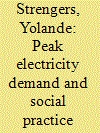

|
|
|
|
|
| Publication |
2012.
|
| Summary/Abstract |
Demand managers currently draw on a limited range of psychology and economic theories in order to shift and shed peak electricity demand. These theories place individual consumers and their attitudes, behaviours and choices at the centre of the problem. This paper reframes the issue of peak electricity demand using theories of social practices, contending that the 'problem' is one of transforming, technologically-mediated social practices. It reflects on how this body of theory repositions and refocuses the roles and practices of professions charged with the responsibility and agency for affecting and managing energy demand. The paper identifies three areas where demand managers could refocus their attention: (i) enabling co-management relationships with consumers; (ii) working beyond their siloed roles with a broader range of human and non-human actors; and (iii) promoting new practice 'needs' and expectations. It concludes by critically reflecting on the limited agency attributed to 'change agents' such as demand managers in dominant understandings of change. Instead, the paper proposes the need to identify and establish a new group of change agents who are actively but often unwittingly involved in reconfiguring the elements of problematic peaky practices.
|
|
|
|
|
|
|
|
|
|
|
|
|
|
|
|
| 11 |
ID:
166358
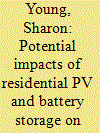

|
|
|
|
|
| Summary/Abstract |
Australia has one of the highest penetrations of residential PV in the world and is projected to see substantially more deployment in coming years, with a growing proportion of this being coupled with battery energy storage (BES). Previous analysis of the implications of these residential distributed energy resources (DERs) has tended to focus on the individual private benefits to households that deploy them, their direct technical and revenue impacts on network businesses, or broader electricity industry implications. This paper seeks to quantify the economic impacts of residential PV and BES on electricity network businesses, from residential to wholesale market region level. One key impact is reductions in network business revenues as households purchase less electricity from the grid. However, we also consider the potential savings for network businesses as these PV and BES deployments reduce peak network demand from residential to wholesale market level, a key driver of network investment and hence network business costs. Our findings for the Sydney region suggest that potential network investment cost reductions could even outweigh the loss of revenue. Tariff design will have a key role in ensuring that residential PV and BES deployment offers value both to households as well as network businesses.
|
|
|
|
|
|
|
|
|
|
|
|
|
|
|
|
|
|
|
|
|